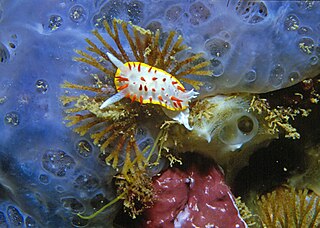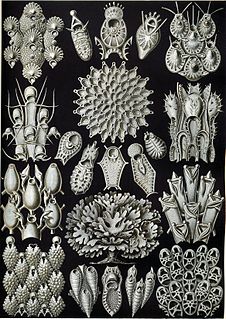Edward Oscar Ulrich was an invertebrate paleontologist specializing in the study of Paleozoic fossils.

John Landis Bassler was an American professional baseball player and coach. He played as a catcher in professional baseball for 26 seasons between 1911 and 1937, including nine seasons in Major League Baseball with the Cleveland Naps in 1913 and 1914 and the Detroit Tigers from 1921 to 1927.
Hederellids are extinct colonial animals with calcitic tubular branching exoskeletons. They range from the Silurian to the Permian and were most common in the Devonian period. They are more properly known as "hederelloids" because they were originally defined as a suborder by Bassler (1939), who described about 130 species. Although they have traditionally been considered bryozoans, they are clearly not because of their branching patterns, lack of an astogenetic gradient, skeletal microstructure, and wide range in tube diameters. Work continues on assessing the true affinities of hederelloids, but they appear to be most closely related to phoronids and other lophophorates.

Bugula is a genus of common colonial arborescent bryozoa, often mistaken for seaweed. It commonly grows upright in bushy colonies of up to 15 cm in height.
The Maryland Open is the Maryland state open golf tournament, open to both amateur and professional golfers. It is organized by the Maryland State Golf Association. It has been played annually since 1921 at a variety of courses around the state. It was considered a PGA Tour event briefly in the 1920s.
The Daniel Giraud Elliot Medal is awarded by the U.S. National Academy of Sciences "for meritorious work in zoology or paleontology study published in a three- to five-year period." Named after Daniel Giraud Elliot, it was first awarded in 1917.

The Bucephaloidea are a superfamily of trematode flatworms, belonging to the large group Digenea. Many species are endoparasites of mollusks and fish. The name Bucephalus meaning "ox head" was originally applied to the genus Bucephalus because of the horn-like appearance of the forked tail (furcae) of its cercaria larva. By what Manter calls a "curious circumstance", horns are also suggested by the long tentacles of adult worms.

Ray Smith Bassler was an American geologist and paleontologist.

Triphyllozoon is a genus of bryozoans in the family Phidoloporidae.

Reteporella is a genus of bryozoans in the family Phidoloporidae.

Schizoporella is a genus of bryozoans in the family Schizoporellidae.
Ferdinand Canu (1863–1932) was a French paleontologist and author. In 1923 he was awarded Daniel Giraud Elliot Medal for his work North American Later Tertiary and Quaternary Bryozoa.
Raymond Carroll Osburn was an American zoologist.
Marcusodictyon is a genus of problematic fossils. It has been considered the oldest bryozoan in several publications. Taylor (1984) revised the systematics of the genus and removed it from Bryozoa. The fossil constitutes a phosphatic network of low ridges that enclose polygons about 0.3–1.2 mm wide that are generally 6-sided but can be 4-, 5- or 7-sided. The internal microstructure of Marcusodictyon is composed of laminae parallel to external surfaces of ridges. Marcusodictyon occurs on late Cambrian and Tremadocian lingulate brachiopods of Baltica.
Watersiporidae is a family of bryozoans in the order Cheilostomatida.

Cupuladria is a genus of bryozoans in the suborder Flustrina.

Major General Robert H. "Shorty" Soule was a senior officer in the United States Army. He commanded the 188th Glider Infantry Regiment of the 11th Airborne Division in the Philippines campaign during World War II. He later served as military attaché to the Republic of China, and commanded the 3rd Infantry Division during the Korean War. Soule died of a heart attack in Washington, D.C.. He is buried at Arlington National Cemetery with his wife Genevieve Hoffman Soule (1898–1992).
Paralicornia is a genus of gymnolaematan bryozoans.
Candidae is a family of gymnolaematan bryozoans.
Irene Agnes McCulloch was a marine biologist and USC biological sciences professor. McCulloch started at the University of Southern California in 1924 where the marine biology research department lacked funding and resources. To better the research being done, McCulloch convinced George Allan Hancock to fund the G. Allan Hancock Foundation for Marine Research, which was then renamed the Hancock Institute for Marine Studies. McCulloch was given her own foundation in 1969 at USC to continue marine biology research. McCulloch studied microbes within the Pacific Ocean with her main focus being foraminifera.









